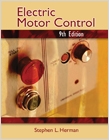Description: With a highly practical approach, ELECTRIC MOTOR CONTROL, 9E provides a useful and effective tool for anyone who will install, monitor, and/or maintain motor controls. The book begins by introducing the simplest of equipment and then builds upon this knowledge, step-by-step, enabling readers to learn how to draw and interpret motor control schematic diagrams. Subsequent units provide useful information on motor control components and how they are connected to form complete control circuits. Product Benefits: - Final unit 60 on troubleshooting techniques provides real-life tools for readers.
- Updated content includes coverage of Mercury bulb float switches.
- Chapter 3 Magnetic Line Voltage Starters has been heavily revised.
- Over 30 updated photos and line illustrations.
- VISUAL AIDES: Includes updated artwork and schematic diagrams.
- INSTRUCTIONS: Step-by-step instructions are given on how to use the voltmeter, ammeter, and ohmmeter when troubleshooting a control circuit.
- UNITS: Short, self-contained, 4-10 page units are a key trademark feature of this book so that content can be easily matched up with teacher and learner needs.
Table of Contents: 1. General Principles of Electric Motor Control.
2. Fractional and Integral Horsepower Manual Motor Starters.
3. Magnetic Line Voltage Starters.
4. Symbols.
5. Interpretation and Application of Simple Wiring and Elementary Diagrams.
6. Push Buttons and Control Stations.
7. Relays.
8. Contactors.
9. Timing Relays.
10. Pressure Switches and Regulators.
11. Float Switches.
12. Flow Switches.
13. Limit Switches and Proximity Control.
14. Phase Failure Relays.
15. Solenoid Valves.
16. Temperature Switches.
17. Two-Wire Controls.
18. Three-Wire and Separate Controls.
19. Hand-Off-Automatic Controls.
20. Multiple Push Button Stations.
21. Interlocking Methods for Reversing Control.
22. Sequence Control.
23. Jogging (Inching) Control Circuits.
24. Time-Delay, Low-Voltage Release Relay.
25. The Motor and Starting Methods.
26. Primary Resistor-Type Starters.
27. Autotransformer Starters.
28. Part Winding Motor Starters.
29. Automatic Starters for Star-Delta Motors.
30. AC Solid-State Reduced Voltage Controller.
31. Controllers for Two-Speed, Two-Winding (Separate Winding) Motors.
32. Two-Speed, One-Winding (Consequent Pole) Motor Controller.
33. Four-Speed, Two-Winding (consequent Pole) Motor Controller.
34. Wound Rotor Motors and Manual Speed Control.
35. Push Button Speed Selection.
36. Automatic Acceleration for Wound Rotor Motors.
37. Automatic Speed Control for Wound Rotor Motors.
38. Solid-State Adjustable Speed Controller for AC Wound Rotor Motors.
39. Synchronous Motor Operation.
40. Push Button Synchronizing.
41. Timed Semiautomatic Synchronizing.
42. Synchronous Automatic Motor Starter.
43. About DC Motors.
44. Use of Reduced Voltage for Starting.
45. Across-the-Line Starting.
46. Compensating and Definite Time Control Starting.
47. Solid-State Adjustable Speed Control.
48. Plugging.
49. Electric Brakes.
50. Dynamic and Regenerative Braking.
51. Electric and Electronic Braking.
52. Direct Drives and Pulley Drives.
53. Gear Motors.
54. Variable-Frequency Mechanical Drives.
55. AC Adjustable Frequency Drives.
56. Magnetic Clutch and Magnetic Drive.
57. DC Variable-Speed Control --- Motor Drives.
58. Programmable and Motion Control.
59. Motor Startup and Troubleshooting Basics.
60. Troubleshooting Techniques. |

